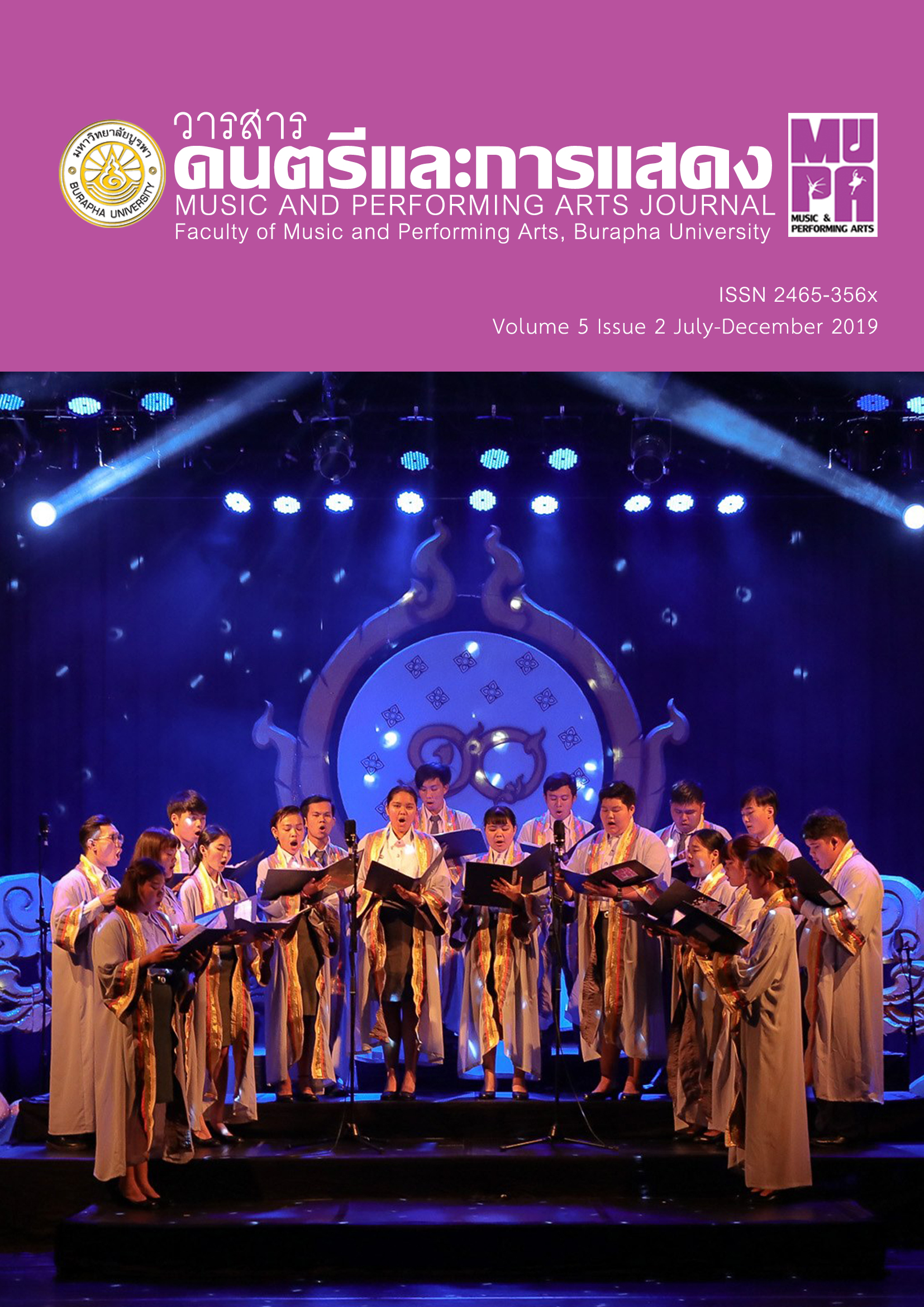The Song Composition of Pleng Tub-Ruang, ‘Bua Sam Lao’
คำสำคัญ:
Lotus, Three Types of Lotuses, Pleang Tub-Ruangบทคัดย่อ
The Song Composition of Pleng Tub-Ruang, ‘Bua Sam Lao’ aims to explore the background of Sutta Patika, in Majjhima Nikaya, the second of the three divisions of the Tripitaka or Pali Canon and to create Pleng Mahori Tub-Ruang called “Bua Sam Lao” to propagate the idea to Buddhists. The study found that lotuses have strong connections with religious beliefs and convey an impression of purity and good fortune as seen in various works of art of both Thai and other Buddhist countries. Bua Sam Lao is the Buddha’s teaching regarding human beings’ development of intelligence. Each level of intelligence is compared with different growth level of lotuses. The lotuses rising above water and those being right at the surface of water are compared to higher levels of learning capability or the ability to achieve enlightenment according to each person’s level of intelligence. This concept is found in the book of Sutta Patika in Tripitaka describing the period prior to the Buddha’s propagation. The Buddha compared each group of people with the three types of lotuses: 1) Underwater or a person whose learning and training are hard to practice, 2) At the surface of water: a person who should be trained and explained in order to learn and understand, and 3) Rising above water: a person who understands the lesson as soon as he/she learns or a person who is ready to become enlightened. The comparison was made as a benefit and guideline for the propagation that is suitable for each type of person and for their ability to learn the teaching including the Buddha’s enlightenment
The Song Composition of Pleng Tub-Ruang, ‘Bua Sam Lao’ as a propaganda for Buddhists is considered a consequence of the study of the Buddha’s teaching. Started from the composition process by analyzing the previous songs and use them as a guideline for the song composition.
The researcher studied a number of Thai songs related to flowers to draw a conclusion to use as a guideline for the song composition. The study of the songs related to flowers found that: 1) To specify the mode, if a musical dialect is Thai, there will be 2-3 modes. However, if a song does not contain Thai musical dialect, 1) To specify the mode, if a musical dialect is Thai, there will be 2-3 modes. However, if a song does not contain Thai musical dialect, one mode is usually specified. 2) The whole song composition involves arrangement of the notes from low to high or from high to low and the dynamic is not emphasized. 3) The beginning of most of the songs is played in two patterns which are the arrangement of the notes from low to high and from high to low and usually ends with the high-to-low.
Moreover, some special methods for the song composition are found. From the study of the Thai song composition methods for Thai performance, it is found that the dance songs regarding flowers composed by Kru Montri Tramote contain the intro or the herald melody to create a distinct musical and dance performance identity.
It is also found that in most dance song melodies, the verses usually end with a syncopation.
For the overture and Pleng Tao talking about flowers, the melody is inserted with Look Lor Look Kat. Moreover, all the songs related to flowers are usually composed in the main melody (non-improvised) and Look Tok sound is normally placed between the first and the latter verse to make it varied across the song.
Then, the researcher composed the song by using the principle as a guideline for composing the melody. The researcher arranged the song set (Tub Pleng) in Mahori pattern which consists of 2 parts.
The first part is the song set that conveys the groups of people who can be compared with the three types of lotuses according to the Buddha’s teaching. The song starts with the herald “Pathombhumi” (Primary) and 3 minor songs which are “Pleng Neuyyaboos”, “Pleng Boosnamdul”, and “Pleng Suriyakomes”.
The second part depicts the Buddha’s teaching, that is, the knowledge and lessons that the Buddha used to open the eyes of people. The composition was made by the arrangement of the vocal lyrics from the Buddha’s teaching that Buddhists should make self-improvement in order to have intellectual potential and to make more effort to learn.
The part consists of 3 songs: “Pleng Hantamayung”, “Pleng Bot Kat Dhammachakkappavattana Sutta” and “Pleng Dhammachakkappavattana Sutta”. Especially, “Pleng Dhammacakkappavattana Sutta” has 7 minor songs which are Pleng Pathom Dammachakka, Pleng Koo Payayam, Pleng Plai Koo Payayam, Pleng Ariyasaj Si, Pleng Dhevanang, Pleng Pitisarn, and Pleng Tatiyabhumi. The researcher composed the lyrics including the content which is in the form of Glon Suphap (a type of Thai sonnet) following the pattern of that of Mahori. The melody was also composed by using the principles following the conclusion of the approach to composing the songs related to flowers as mentioned earlier. These approach
es are accompanied with the following methods: 1) Extend the melody of the old songs together with extending the rhythm 2) Contract the melody of the old songs and reduce the rhythm 3) Compose a new song from imagination and 4) Insert Look Lor Look Kat
melody



